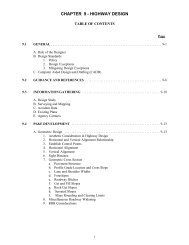environmental assessment - Eastern Federal Lands Highway ...
environmental assessment - Eastern Federal Lands Highway ...
environmental assessment - Eastern Federal Lands Highway ...
You also want an ePaper? Increase the reach of your titles
YUMPU automatically turns print PDFs into web optimized ePapers that Google loves.
ENVIRONMENTAL<br />
ASSESSMENT<br />
I-95 DEFENSE ACCESS ROADS RAMPS TO<br />
ENGINEER PROVING GROUND<br />
Streams in the watershed can be characterized as degraded, with most having poor habitat and biological<br />
conditions. Measures of benthic macroinvertebrate community health are low, with species being those<br />
adapted to degraded conditions. Most of the small tributaries are highly incised, and a pattern of stream widening<br />
has been observed due to increased flows from surrounding developments. The ongoing erosion and<br />
sloughing of banks results in unstable benthic habitat, with unstable sediment bars, tree falls, and logjams.<br />
Imperviousness exceeds 25% throughout much of the watershed. A dam roughly midway within the mainstem<br />
of Accotink Creek holds Lake Accotink, which imposes some hydrologic control and somewhat moderates<br />
the effects of high flow volumes in the mainstem. The dam also constitutes a barrier to migration of<br />
aquatic species. Fairfax County has established stream valley parks along portions of Accotink Creek beyond<br />
the limits of the project to preserve riparian habitat, help protect water quality, and, in some instances, provide<br />
trails for public recreation.<br />
The proposed project would cross Field Lark Branch, a small tributary that joins Accotink Creek to the south<br />
of the project. Roughly 45 linear feet of stream bottom in Field Lark Branch would be displaced by the installation<br />
of culverts to carry the stream under the road. The culverts would be countersunk below the stream<br />
bottom profile to enable reestablishment of natural stream bottom inside the culverts. Temporary siltation<br />
likely would occur during construction. Long-term water quality effects that might be attributable to operation<br />
and maintenance of the roadway could include incremental increases in pollutant loads in highway<br />
runoff, such as particulates, metals, oil and grease, nutrients, and other substances. However, temporary and<br />
permanent stormwater management measures, including vegetative controls, detention basins, and filtration<br />
systems would be implemented on this project to minimize potential short-term and long-term effects on<br />
water quality. These measures would reduce or detain stormwater discharge volumes and remove pollutants.<br />
The project design would incorporate erosion and sediment control measures as required in FHWA Specifications.<br />
The requirements and special conditions of any required permits for work in and around surface waters<br />
would be incorporated into construction contract documents. The construction contractor will be required to<br />
comply with pollution control measures specified in VDOT’s Road and Bridge Specifications.<br />
Wetlands<br />
Wetlands in the immediate project vicinity are limited to a few small (less than 0.1 acre) palustrine forested<br />
(PFO) wetland swales associated with Field Lark Branch. None of these designated wetlands will be directly<br />
impacted by the proposed project.<br />
Mitigation<br />
In accordance with regulatory and permitting programs, compensation for unavoidable stream impacts will be<br />
provided as part of the proposed project. Such compensation could be accomplished in a variety of ways. The<br />
most desirable would be to construct stream restoration at or near the site of impact. Should adequate compensation<br />
not be practicable onsite, other opportunities within the Accotink Creek watershed will be explored.<br />
Such opportunities could include uneconomic remnants of privately owned land along streams. Specific<br />
identification of such sites is beyond the scope of this study, but would be done in concert with permitting activities.<br />
Should no suitable sites be identified, purchase of credits at an existing mitigation bank with a service<br />
area encompassing the project would be pursued. As a last resort, should it not prove practicable to provide<br />
adequate compensation in any of the above methods, payment to the Trust Fund will be provided.<br />
14
















